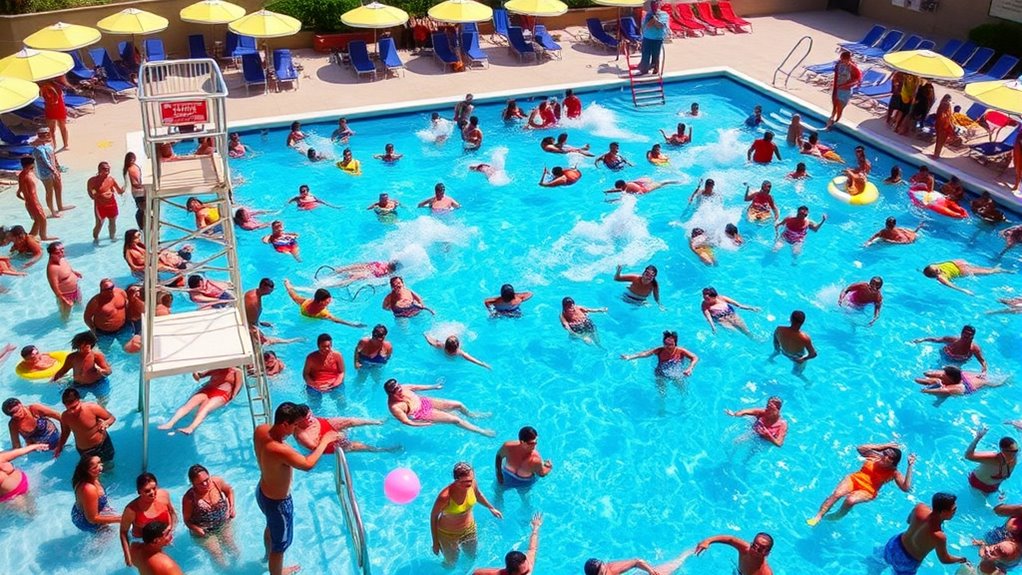To determine how many swimmers are too many, you need to contemplate your pool’s size, water depth, and safety standards—usually around one person per 15 square feet. Overcrowding can compromise safety, water quality, and swimmer comfort, so managing peak times and using real-time monitoring can help. By following safety guidelines and adjusting staffing accordingly, you’ll keep your pool safe and enjoyable. If you’d like tips on calculating your capacity and handling surges, explore further.
Key Takeaways
- Capacity depends on pool size, water depth, and local safety regulations, typically measured as one person per 15-20 sq ft.
- Overcrowding impairs lifeguard supervision, increases accident risk, and diminishes water quality and swimmer comfort.
- Real-time monitoring systems, sensors, and surveillance help track swimmer numbers and prevent exceeding safe capacity.
- Managing peak times with staggered schedules, signage, and capacity alerts ensures safety and avoids overcrowding.
- Maintaining appropriate staff-to-swimmer ratios and conducting regular safety checks are essential to handle surge capacities safely.
Understanding Bather Load and Its Importance

Have you ever wondered why managing the number of swimmers at a pool matters so much? Bather load refers to the number of people using the pool at a given time. It’s essential because too many swimmers can lead to safety issues, lower water quality, and increased wear and tear on the facility. When the bather load is too high, lifeguards may struggle to monitor everyone effectively, increasing the risk of accidents. Additionally, overcrowding can cause discomfort, making it harder for swimmers to enjoy the pool. By understanding and controlling bather load, you help guarantee a safe, enjoyable environment for everyone. It also helps maintain the pool’s infrastructure, preventing damage caused by overuse. Proper management of bather load is key to a well-functioning, safe swimming facility. Regularly monitoring water quality and adjusting capacity accordingly ensures both safety and comfort for all users.
Calculating Maximum Safe Capacity for Pools
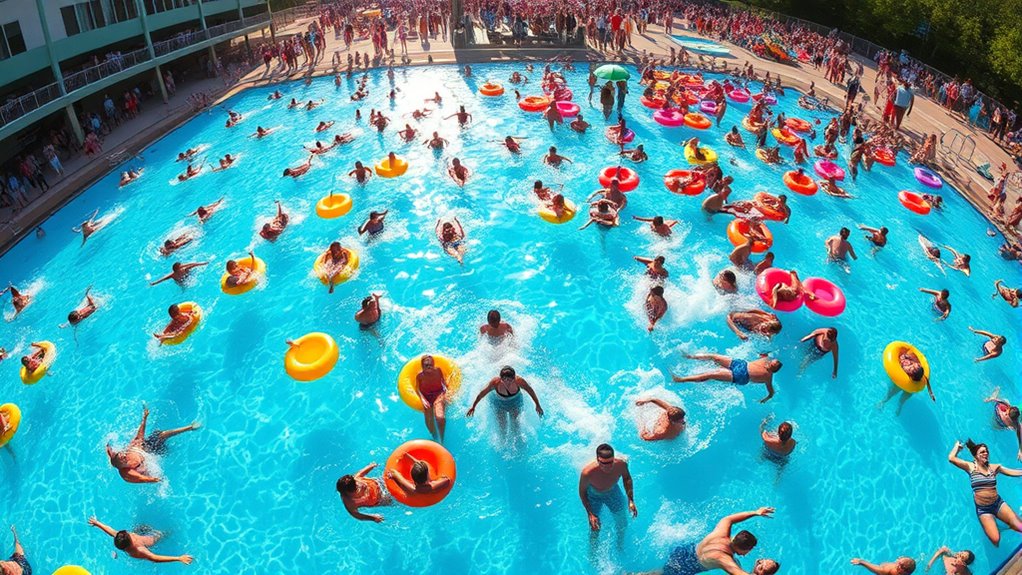
To guarantee pool safety, you need to understand its capacity limits and what factors affect how many swimmers it can handle safely. By calculating the ideal load, you can prevent overcrowding and reduce risks. Let’s explore how to determine the right maximum safe capacity for your pool. Incorporating data privacy considerations can also help ensure that any monitoring or management systems used adhere to privacy standards.
Understanding Pool Capacity Limits
Understanding pool capacity limits is essential for ensuring safety and comfort for all swimmers. To determine the maximum safe capacity, you need to take into account factors like pool size, water depth, and local regulations. These guidelines help prevent overcrowding and reduce the risk of accidents. You can calculate capacity by:
- Measuring the pool’s surface area in square feet or meters
- Consulting safety standards for swimmer density (e.g., 1 person per 15 sq ft)
- Adjusting for water depth and pool features
- Considering lifeguard staffing requirements
- Following local health and safety codes
- Incorporating philosophical insights to better understand the importance of safety protocols and ethical responsibility.
Factors Influencing Safe Swimmers
When calculating the maximum safe capacity for a pool, several key factors directly influence the number of swimmers it can accommodate without compromising safety. The pool’s size and shape set the foundational limit, as larger pools naturally handle more people. Water circulation and filtration systems also play a critical role, ensuring water quality remains safe as occupancy increases. Additionally, the depth of the pool impacts safety; deeper areas require more cautious limits. Your local safety regulations and standards provide specific guidelines based on these factors, helping you determine appropriate capacity limits. In conclusion, the presence of lifeguards and safety equipment influences how many swimmers can be safely monitored and managed at once. Considering these factors ensures you set a capacity that maintains safety and complies with regulations.
Calculating Optimal Pool Load
Calculating the ideal pool load involves determining the maximum number of swimmers a pool can safely accommodate at any given time. To do this, consider factors like pool size, water circulation, and safety regulations. Understanding these elements helps you prevent overcrowding and ensure swimmer safety. Additionally, implementing proper color accuracy measures in your pool lighting can enhance visibility and safety during nighttime use.
Factors Influencing Surge Capacity and Crowding

Various factors influence surge capacity and crowding at bathing facilities, shaping how well they can handle peak demand. One key element is the size and layout of the space, which determines how many people can comfortably fit without feeling overcrowded. The availability of amenities, such as showers, lockers, and seating, also affects how smoothly the influx of swimmers is managed. Additionally, the timing of peak usage—like weekends or holidays—plays a role in crowd levels. Weather conditions, such as heat or rain, can increase or decrease attendance unexpectedly. Ultimately, the capacity of access points, like entrances and exits, influences how quickly people can enter or leave, impacting overall crowding. Proper planning and design can improve lifestyle to better accommodate fluctuating crowds. Understanding these factors helps you anticipate and manage busy periods effectively.
Regulatory Guidelines and Safety Standards
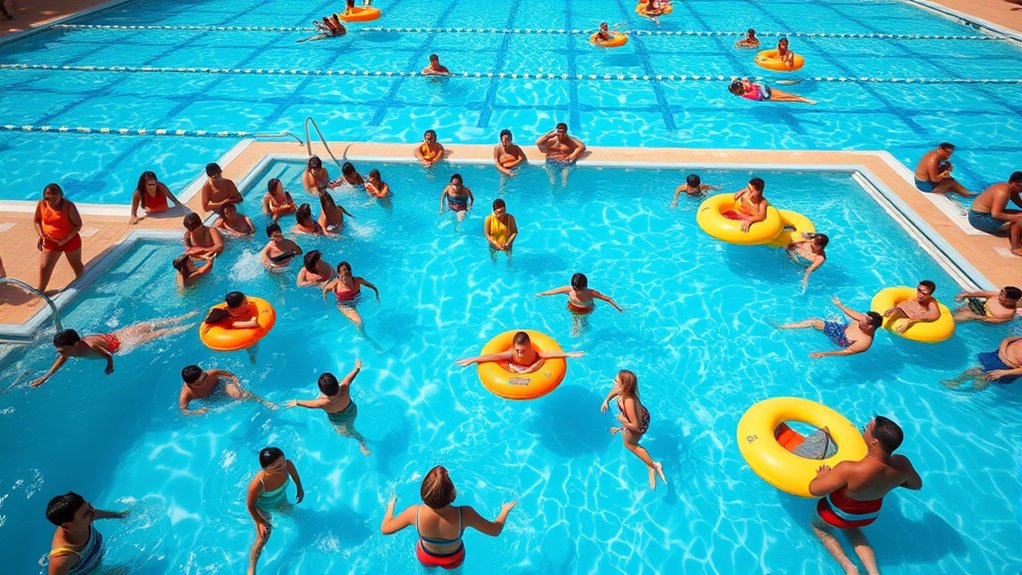
Regulatory guidelines and safety standards set essential requirements to guarantee that bathing facilities operate safely and efficiently. They establish limits for maximum bather loads, staffing ratios, and equipment standards, ensuring environments remain safe during peak times. These standards help prevent overcrowding, reduce accidents, and promote hygiene. By adhering to these regulations, you assure compliance with legal requirements and protect swimmers from potential hazards.
Key points include:
- Maximum bather capacity based on pool size
- Staff-to-swimmer ratios for supervision
- Regular safety inspections and maintenance
- Certification requirements for lifeguards
- Emergency response procedures and signage
Following these guidelines helps you maintain a safe swimming environment, minimizes liability, and ensures that your facility provides a secure experience for all users.
Strategies for Managing Pool Usage During Peak Times
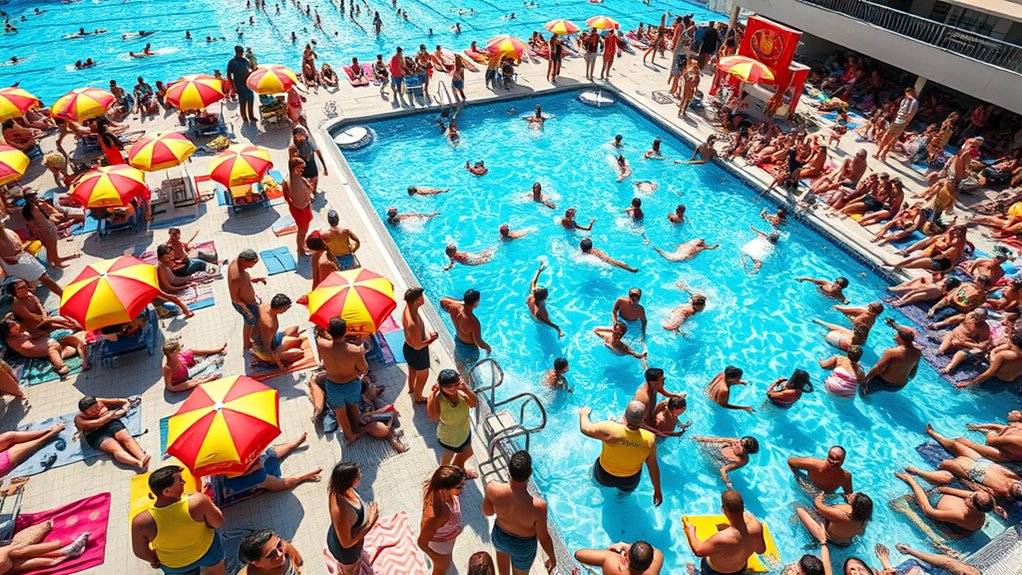
Managing pool usage during peak times requires proactive strategies to guarantee safety, comfort, and efficient flow of swimmers. One effective approach is implementing timed entry systems, which control the number of swimmers entering the pool at once. Clear communication, such as signage and announcements, helps set expectations and manage behavior. You can also organize staggered schedules or designated swim times for different groups to reduce congestion. Consider the following table to highlight key strategies:
| Strategy | Benefit |
|---|---|
| Timed Entry Control | Limits crowd size, improves safety |
| Staggered Swim Sessions | Distributes swimmers evenly, reduces overload |
| Clear Signage | Guides behavior and sets expectations |
| Staff Monitoring | Ensures compliance and quick response to issues |
Additionally, understanding swimmer capacity helps in setting appropriate limits to prevent overcrowding. These tactics keep the pool safe and enjoyable during busy periods.
Monitoring and Adjusting for Optimal Pool Safety
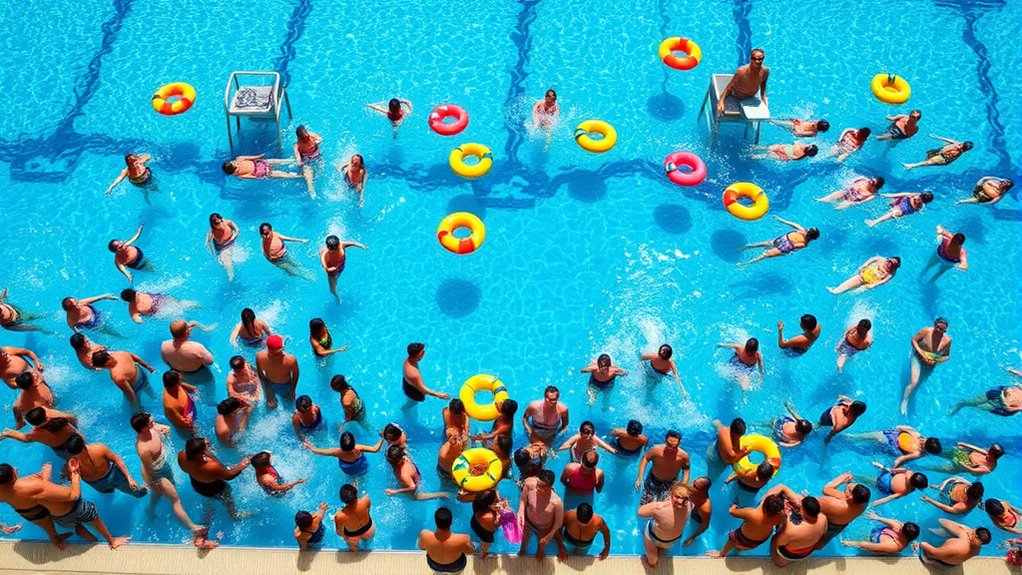
To keep your pool safe, you need to monitor capacity in real time, so you can respond quickly to changing bather loads. Using technology for live capacity tracking helps you identify when numbers approach safety limits. Coupling this with adaptive staffing guarantees you’re ready to manage surges effectively and maintain safety at all times. Incorporating healthy eating tips can also promote overall well-being for staff and swimmers alike.
Real-time Capacity Tracking
How can pool operators guarantee safety as attendance fluctuates throughout the day? Real-time capacity tracking lets you monitor swimmer numbers continuously, helping you make immediate adjustments. Using digital counters, sensors, and surveillance, you stay informed about current bather load. This data allows you to:
- Identify peak times quickly
- Adjust entry policies dynamically
- Communicate capacity limits to staff and guests
- Prevent overcrowding before it becomes unsafe
- Optimize pool usage without risking safety
Whole-house water filtration systems can also serve as a model for integrating comprehensive monitoring solutions to ensure safety and water quality.
Adaptive Staffing Strategies
Monitoring real-time capacity data enables pool operators to adjust staffing levels promptly, ensuring safety keeps pace with fluctuating attendance. Adaptive staffing strategies involve analyzing attendance patterns and reallocating lifeguards as needed to maintain ideal supervision. This proactive approach helps prevent overcrowding and reduces accident risks. Flexibility is key—by monitoring data continuously, you can scale staffing up during peak times and down during quieter periods. Consider implementing a table to visualize staffing adjustments:
| Time of Day | Expected Attendance | Staff Needed |
|---|---|---|
| Morning | Low | 2 |
| Afternoon | Peak | 5 |
| Evening | Moderate | 3 |
Using this data-driven approach, you ensure safety remains a priority without overstaffing or understaffing. Additionally, integrating real-time monitoring technologies can further enhance responsiveness and safety management.
Frequently Asked Questions
How Does Bather Load Affect Pool Chemical Levels and Water Quality?
You’ll notice that higher bather loads increase the demand for chemicals, like chlorine, to disinfect the water and control bacteria. As more swimmers use the pool, contaminants like sweat, oils, and dirt introduce more impurities. This can cause the chemical levels to fluctuate, making it harder to maintain water quality. To keep the water safe and clear, you need to monitor and adjust chemical levels frequently during busy times.
What Are the Signs Indicating a Pool Is Overcrowded or Unsafe?
You’ll notice overcrowding when the pool feels packed, and swimmers have difficulty moving comfortably. Watch for water clarity issues, strong chemical smells, or increased debris on surfaces, which signal water quality problems. Also, if lifeguards or staff seem overwhelmed or if safety rules are ignored, it’s a sign the pool might be unsafe. Always listen to staff instructions and avoid swimming if conditions seem unsafe or overly crowded.
How Can Technology Improve Crowd Management and Safety Monitoring?
Technology can greatly improve crowd management and safety monitoring by providing real-time data on swimmer numbers. You can use automated counters, CCTV with AI analytics, and mobile apps to track capacity and alert staff when limits are approached. These tools help you respond quickly to overcrowding, ensure safe swimmer ratios, and enhance overall safety by facilitating proactive decisions and better resource allocation during peak times.
Are There Specific Age Groups or Swimmer Types That Require Different Capacity Limits?
Yes, you should set different capacity limits for various age groups and swimmer types. Young children and inexperienced swimmers need smaller group sizes to guarantee safety, while experienced swimmers can handle larger groups. Seniors or individuals with mobility issues may also require lower limits. By tailoring capacity limits, you help prevent overcrowding and accidents, creating a safer environment for everyone. Always adapt based on specific pool features and staff recommendations.
What Are the Long-Term Health Impacts of Consistently Exceeding Capacity Guidelines?
Consistently exceeding capacity guidelines can lead to increased stress on your body, raising your risk of dehydration, heat exhaustion, and fatigue. Over time, this can weaken your immune system and cause long-term health issues like cardiovascular strain. You might also experience mental fatigue, reducing your ability to make quick decisions. To stay safe, always follow recommended limits, listen to your body, and avoid pushing yourself beyond safe capacity, especially in crowded or hot environments.
Conclusion
Knowing the bather load helps you keep swimmers safe and enjoyable. Did you know that overcrowding can increase the risk of accidents by up to 50%? By understanding capacity limits, monitoring peak times, and following safety standards, you can prevent dangerous overcrowding. Stay proactive by adjusting pool usage and implementing effective management strategies. With the right approach, you guarantee a fun, safe experience for everyone while minimizing risks.
